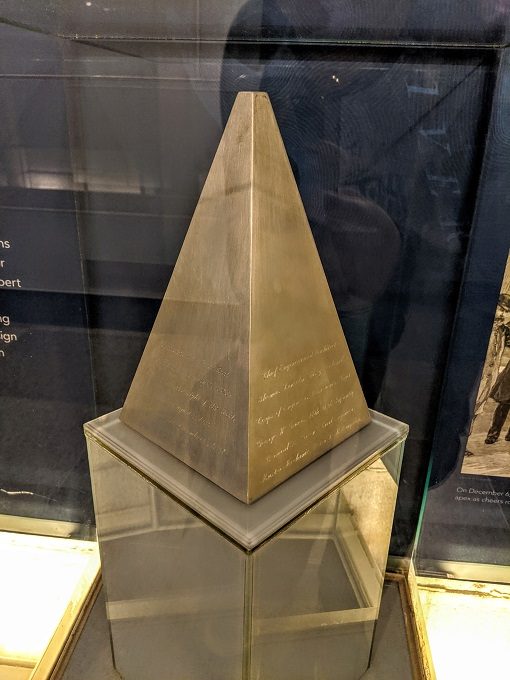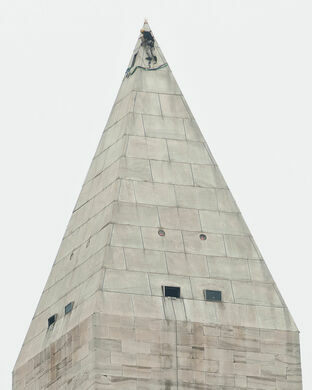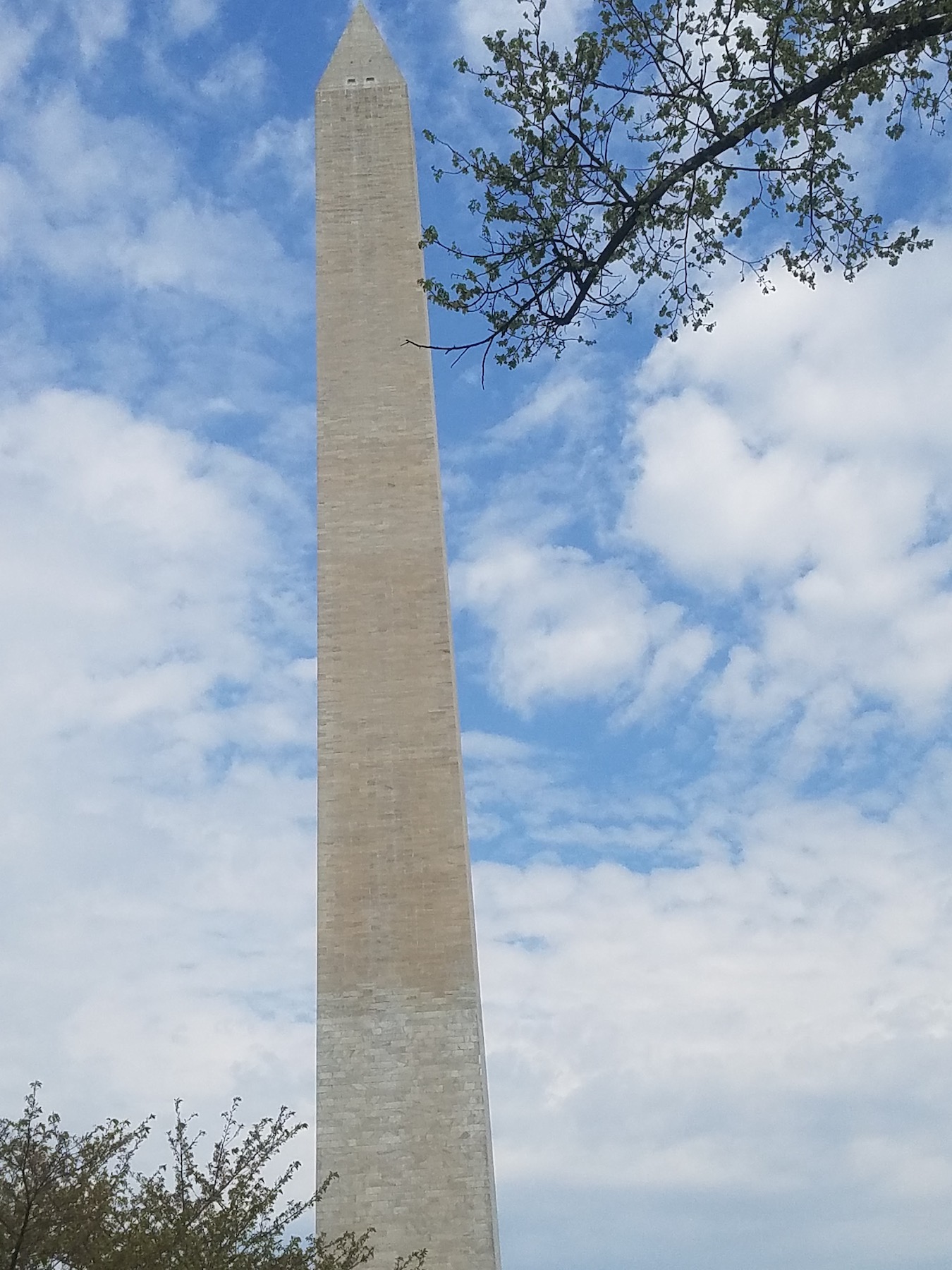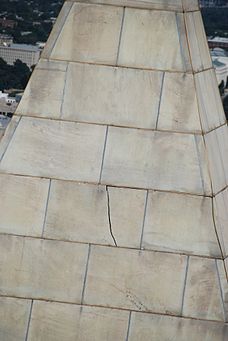Washington Monument:
One of the most celebrated and spectacular sights on the National Mall, the Washington Monument, stands as a grand tribute to our nation's first President, George Washington. The 555 foot obelisk is also one of the oldest and most recognizable memorials in the City. While construction began in 1848, the monument was not completed until 1884 because of financial difficulties during the Civil War.Inside, 192 memorial stones that were donated from various states, cities and historical societies are seen on the walls.
At the bottom of the monument, fifty American flags fly in honor of George Washington, symbolizing the current fifty states and the nation he founded.
Fun Facts:
- The famous monument opened to the public on October 9, 1888.
- The original design of the Washington Monument was quite different that what it is today.
- The first design featured a rotunda and a Roman-like George Washington.
- The cornerstone contained a portrait of George Washington, newspapers, US coins and a copy of the Constitution. It was laid out in a ceremony on July 4, 1848.
- Washington DC is not the only place with a Washington Monument. There are two more in Maryland, one in Boonsboro and another in Baltimore. The Baltimore monument was designed by the same architect that built the one in DC.
- Construction of the monument took 40 years. The monument is considered to be an engineering marvel. Mortar was not being used in the process, it's held together entirely by gravity and friction.
- The elevator ride to the top of the monument takes about 70 seconds; the original steam-driven elevator took up to 12 minutes.
https://www.trolleytours.com/washington-dc/washington-monument

https://www.google.com/maps/place/Washington+Monument
 Plans for the monument began even before Washington was elected president:
Plans for the monument began even before Washington was elected president:In 1783, the Continental Congress voted to erect a statue of Washington, commander-in-chief of the American army during the Revolutionary War, in the nation's yet-to-be constructed permanent capital city. However, after Washington became president, he scrapped the plans for his memorial, as federal government funds were tight and he didn't want to use public money for the project. After Washington died in 1799, Congress considered building him a pyramid-shaped mausoleum to be housed in the Capitol rotunda; however, the plan never came to fruition.
In 1833, a small group of Washingtonians, unhappy that a proper memorial to the president had not yet been produced in America's capital city, established the Washington National Monument Society to raise private funds for the project. The group, headed by Chief Justice John Marshall, organized a design competition and eventually named as the winner architect Robert Mills (1781-1855), whose credits include the U.S. Treasury Building and the U.S. Patent Office, now home to the National Portrait Gallery and the Smithsonian American Art Museum.
https://www.history.com/news/5-things-you-might-not-know-about-the-washington-monument

Also by architect Robert Mills
Old U.S. Patent Office:


- James Madison had an early role in getting the monument project started:
In 1833, the Washington National Monument Society, a private organization, was among early groups promoting the idea for the tribute to the first President. Madison along with Supreme Court Chief Justice John Marshall started the society. - The first monument design featured a rotunda and a Roman-like George Washington:
The initial winning bid came from architect Robert Mills, whose designed a flat-topped obelisk with a statue of Washington in a chariot, along with statues of 30 Founding Fathers. The current obelisk design was proposed in 1876. - The Masons and the Pope were involved with the monument:
Yes, the Free Masons were involved in the cornerstone ceremony and they used Washington's Masonic symbols in the ceremony. At the 1848 ceremony were 20,000 people, and a container that held copies of the Constitution, the Declaration of Independence and other objects was buried in the cornerstone. - Abraham Lincoln was at the 1848 cornerstone ceremony:
The guest list included three James Buchanan, Lincoln, Andrew Johnson, Dolley Madison and Alexander Hamilton's widow, Betsey Hamilton, and of course, the then-current President, James K. Polk. - So how does the Pope fit into all of this?
The Society asked for people to donate ceremonial stones as part of the construction process. Pope Pius IX donated a memorial stone of marble, which infuriated the anti-Catholic Know Nothing Party. The Know-Nothings got their revenge by rigging the leadership election for the Washington National Monument Society. Congress cut off monument funding for 5 years until the Know Nothings left the group. - The Monument is an engineering marvel:
The Monument's marble blocks are held together by just gravity and friction, and no mortar was used in the process.
https://constitutioncenter.org/blog/10-fascinating-facts-about-the-washington-monument
Rather than go all the way to 600 feet as Mills had intended in the original plan, architect Lincoln Casey was persuaded to make the height of the structure ten times the width of the base, meaning the optimal height for the Washington Monument was 555 feet.

The Washington Monument has 698 steps to get to the top which equals out to be fifty flights of stairs! They stopped letting people climb the Washington Monument about 43 years ago, so if you are younger than 43, you have never had the opportunity to climb it before.
https://washigntonmemorial.weebly.com/significance-and-facts.html

The first 152 feet of the monument, built between 1848 and 1854, is faced with marble from Texas, Md. Work stopped when funds ran out. When construction was about to resume in 1876, the builders discovered that the foundations were inadequate and the monument was sinking and tilting. To stabilize and straighten the monument, wider subfoundations were constructed to a depth of nearly 37 feet.
In 1879 work began again on the upward projection of the monument, and four courses or rows of white marble from Sheffield, Mass., were laid above the Texas marble. However, because of difficulties with timely delivery and quality control, the contract with the Sheffield quarry was annulled in 1880. The upper part of the monument was finished with Cockeysville marble. The three marbles used in the monument can be distinguished by color differences.

Construction on the obelisk started in 1848 and the worked progressed slowly for six years until funding dried up in 1856.
At that point, the obelisk was only half completed and stood just 156 feet tall. After the "Know-Nothing" party failed at an attempt to raise funds and resume construction on the monument, the project still remained unfinished two years later.
When the Civil War broke out in 1861, it caused further delays. Due to the cost of the war, political chaos and physical danger as the war raged towards Washington D.C. and the surrounding areas, it appeared the monument would never be completed. Even after the Civil War ended, the cost of reconstructing the war-torn south overshadowed the need to finish the project and it remained incomplete throughout the 1860s and mid 1870s.
On a trip to Washington in 1867, Mark Twain described the unfinished monument:
It has the aspect of a factory chimney with the top broken off ... cow sheds around its base ... [with] tired pigs dozing in the holy calm of its protecting shadow.
The centennial of the country's birth in 1876 finally renewed the public's interest in the project. President Ulysses S. Grant signed a bill to restart construction on the project but by then the structure was deemed unstable and in need of an overhaul.
After looking briefly at some new design ideas, the Washington National Monument Society decided to stick with the original plan but eliminated the Greek pantheon at the base of the monument. Construction resumed on the monument later that year. The only white marble that workers could obtain was a slightly different shade than the original marble, resulting in the faint color change at the 156 feet mark that can still be seen today.
The monument was finally completed in December of 1884, measuring 555 feet tall and weighing more than 8,000 tons.

Back when the Washington Monument was being constructed, aluminum was a rare metal. Engineers decided to place an aluminum tip atop the monument because the metal wouldn't tarnish or discolor the stones. At the time, this apex was the largest piece of aluminum in the world.
This aluminum apex had inscriptions on all four sides, although some of those are no longer legible:
- North – Joint Commission at setting of capstone. Chester A. Arthur. W. W. Corcoran, Chairman. M. E. Bell. Edward Clark. John Newton. Act of August 2, 1876.
- South – Chief Engineer and Architect, Thos. Lincoln Casey, Colonel, Corps of Engineers. Assistants: George W. Davis, Captain, 14th Infantry. Bernard R. Green, Civil Engineer. Master Mechanic, P. H. McLaughlin.
- East – Laus Deo. Repaired 1934, National Park Service, Department of the Interior. (Laus Deo means "Praise Be To God" in Latin, while the inscription about the repair was added in 1934).
- West – Corner Stone laid on bed of foundation, July 4, 1848. First stone at height of 152 feet laid August 7, 1880. Capstone set December 6, 1884.
https://nohomejustroam.com/14-fun-facts-about-the-washington-monument

In 1885, the Washington Monument suffered from its first lightning strike which cracked one of the stones. The aluminum tip subsequently lost almost half an inch of its height due to being vaporized by lightning strikes.
To help protect the monument, lightning protection systems were installed and have been replaced as necessary over time. An old set of the lightning rods is now on display at the top of the monument – you can see how lightning strikes burned and bent the metal over the years.
https://nohomejustroam.com/14-fun-facts-about-the-washington-monument

Three feet below the aluminum lightning rod at the tip of the Washington Monument, a small panel in the marble allows workers to climb out from inside the obelisk.
The access hatch was installed so that minor repairs can be made to the monument without the need for massive scaffolding. Instead, daredevil National Park Service employees can worm their way out the access hatch, loop ropes over the apex and rappel down the tower. This capability came in handy after the 2011 earthquake when NPS used it to check for structural damage.
The panel is painted white and is nearly impossible to spot from the ground without binoculars.
https://www.atlasobscura.com/places/washington-monument-access-hatch
The Washington Monument is an obelisk within the National Mall in Washington DC. It was built to commemorate George Washington, once commander-in-chief of the Continental Army (1775–1784) in the American Revolutionary War and the first President of the United States (1789–1797).Washington Monument:
- Located almost due east of the Reflecting Pool and the Lincoln Memorial
- Made of marble, granite, and bluestone gneiss.
- It is both the world's tallest predominantly stone structure and the world's tallest obelisk. It stands 554 feet 7+11⁄32 inches tall according to the U.S. National Geodetic Survey (measured in 2014) or 555 feet 5+1⁄8 inches tall, according to the National Park Service (measured 1884)
- It is the tallest monumental column in the world if all are measured above their pedestrian entrances.
- It was the tallest structure in the world between 1884 and 1889, after which it was overtaken by the Eiffel Tower in Paris.
- Fifty American flags fly on a large circle of poles centered on the monument.
Construction:
- Began in 1848 and was halted for a period of 23 years, from 1854 to 1877 due to a lack of funds, a struggle for control over the Washington National Monument Society, and the American Civil War.
- Although the stone structure was completed in 1884, internal ironwork, the knoll, and installation of memorial stones were not completed until 1888.
A difference in shading of the marble, visible approximately 150 feet or 27% up, shows where construction was halted and later resumed with marble from a different source
- The original design was by Robert Mills (1781–1855) of South Carolina, but he did not include his proposed colonnade due to a lack of funds, proceeding only with a bare obelisk.
- July 4, 1848: The cornerstone was laid
- August 7, 1880: The first stone was laid atop the unfinished stump
- December 6, 1884: The capstone was set
- February 21, 1885: The completed monument was dedicated
- October 9, 1888: Officially opened
- The Washington Monument is a hollow Egyptian style stone obelisk with a 500-foot tall column surmounted by a 55-foot tall pyramidion.
- Its walls are 15 feet thick at its base and 1+1⁄2 feet thick at their top.
- The marble pyramidion has thin walls only 7 inches thick supported by six arches, two between opposite walls that cross at the center of the pyramidion and four smaller corner arches. The top of the pyramidion is a large marble capstone with a small aluminum pyramid at its apex with inscriptions on all four sides.
- The lowest 150 feet of the walls, constructed during the first phase 1848–1854, are composed of a pile of bluestone gneiss rubble stones (not finished stones) held together by a large amount of mortar with a facade of semi-finished marble stones about 1+1⁄4 feet thick.
- The upper 350 feet of the walls, constructed during the second phase 1880–1884, are composed of finished marble surface stones, half of which project into the walls, partially backed by finished granite stones.
- The interior is occupied by iron stairs that spiral up the walls, with an elevator in the center, each supported by four iron columns, which do not support the stone structure.
- The stairs contain fifty sections, most on the north and south walls, with many long landings stretching between them along the east and west walls.
These landings allowed many inscribed memorial stones of various materials and sizes to be easily viewed while the stairs were accessible (until 1976), plus one memorial stone between stairs that is difficult to view.
- The pyramidion has eight observation windows, two per side, and eight red aircraft warning lights, two per side.
- Two aluminum lightning rods, connected via the elevator support columns to ground water, protect the monument.
- The monument's present foundation is 37 feet thick, consisting of half of its original bluestone gneiss rubble encased in concrete.
- At the northeast corner of the foundation, 21 feet below ground, is the marble cornerstone, including a zinc case filled with memorabilia.
An earthquake in 2011 slightly damaged the monument, and it was closed until 2014.
LEFT: Crack in a stone at the top of the monument after the 2011 Virginia earthquake
RIGHT: Repairs in 2013It was closed again for elevator system repairs, security upgrades, and mitigation of soil contamination from August 2016 to September 2019.

















